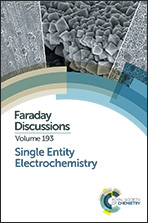Theory of electrostatic phenomena in water-filled Pt nanopores
Abstract
The emerging field of nanoprotonics is concerned with controlling proton distribution and transport in nanoporous media. These phenomena, dictated by the surface charging properties of the host medium, are of vital importance in porous electrodes for fuel cells, electrolysers, supercapacitors and nanofluidic devices. In this theoretical study, we explore the interplay of the metal charging relation with the proton density and oxygen reduction activity in a water-filled nanopore with walls made of platinum. We exploit a non-monotonic charging behavior derived from a refined structural model of the Pt-solution interface. This charging relation replaces the oversimplified linear relation that has been widely used in practical applications. The water-filled pore, with one opening interfacing with a polymer electrolyte membrane as a proton source, always possesses negative surface charge in the potential range of 0–1.0 V (RHE). Therefore, its proton conductivity can be several orders higher than that of pure water. We obtain an analytical expression for the oxygen reduction activity of the nanopore and parameterize it using the polarization data of an ionomer-free thin-film Pt electrode. The structure vs. performance relation of the water-filled Pt nanopore is examined.
- This article is part of the themed collection: Single Entity Electrochemistry

 Please wait while we load your content...
Please wait while we load your content...